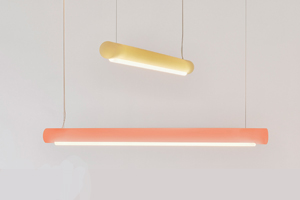Bioplastic lights are made with agricultural byproducts

A RANGE of luminaires are made with a bio-epoxy resin manufactured using byproducts from the agricultural industry.
The Aura lights, the result of a collaboration between British brand Established & Sons and Rotterdam-based designer Sabine Marcelis, consist of a range of two linear pendants made from cylindrical bars of the pastel-hued bioplastic resin.
Over a metre in length and coloured in soft tones of yellow and coral, the translucent Aura lights take their name from the warm glow they emit when illuminated.
The Aura lights form part of Established & Sons’ new Live/Work collection, which the brand has developed in response to the ‘increasingly blurred lines between living and working environments’.
Designed to be suspended from the ceiling, the Aura lights can stand alone or be positioned as part of a group composition.
A replaceable glass LED tube inside the resin casing emits a soft ambient light that is, says the firm, ‘easy on the eyes’, making them suitable for home-working environments as well as relaxed living spaces.
‘My work is currently exclusively available via galleries and this is the first step towards making some lighting available to a wider audience, but in a conscious and sustainable manner,’ Marcelis told the Circular Lighting Report.
The Aura lights are the latest in a series of luminaires made from bioplastic.
Last month, London studio Industrial Facility introduced a table lamp made from a bioplastic derived from castor oil.
The warm touch of the w182 Pastille comes from its renewable and recyclable high-performance material – a bio-polyamide based on over 60 per cent biologically sourced material from the castor plant.
Last year, Trilux Lighting won a Build Back Better Award for its Parelia prototype whose body is made from polylactic acid, a synthetic polymer-based on lactic acid and obtained in an environmentally friendly way from corn starch.


